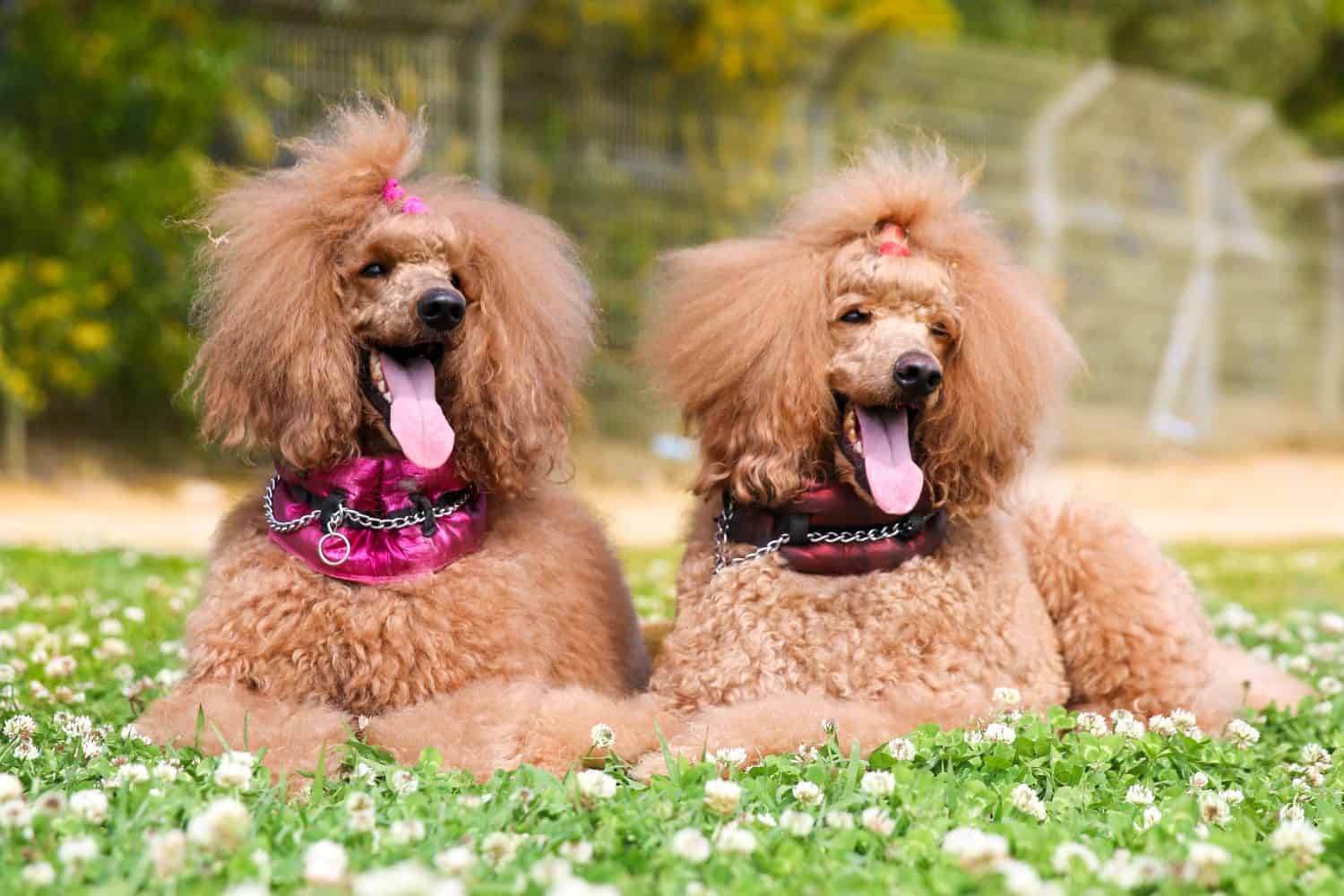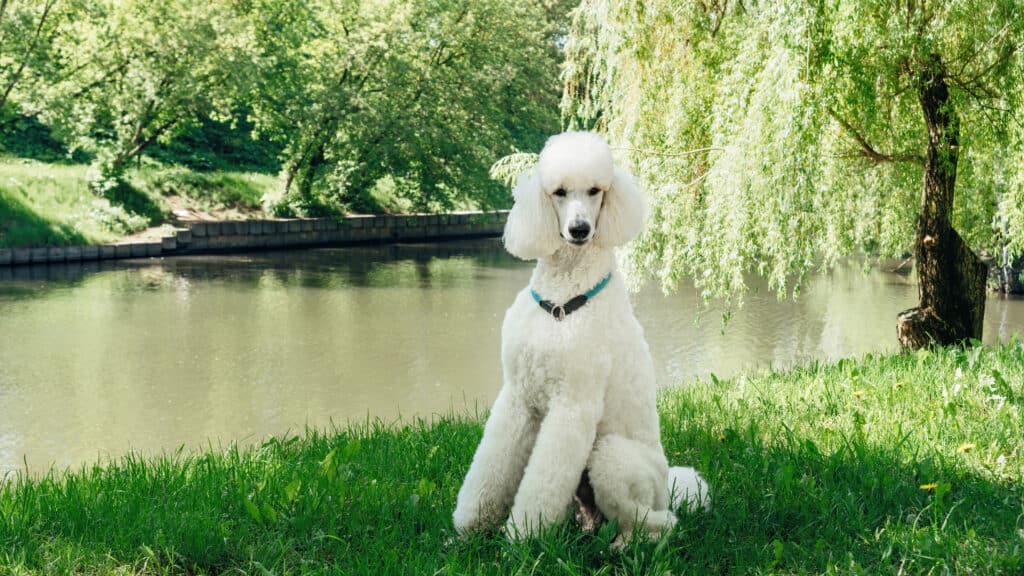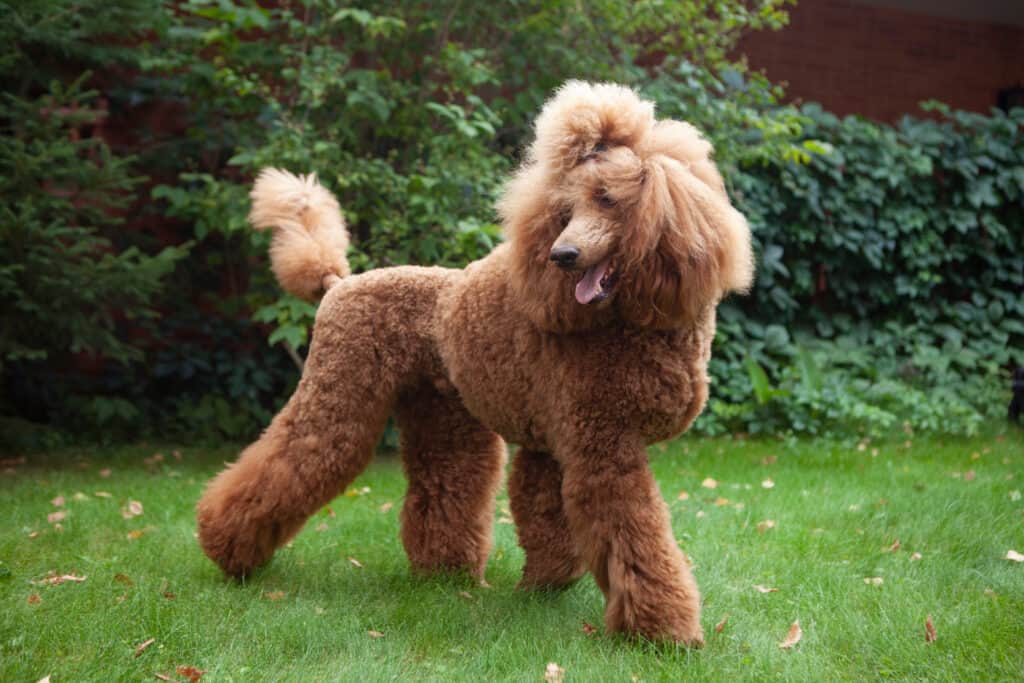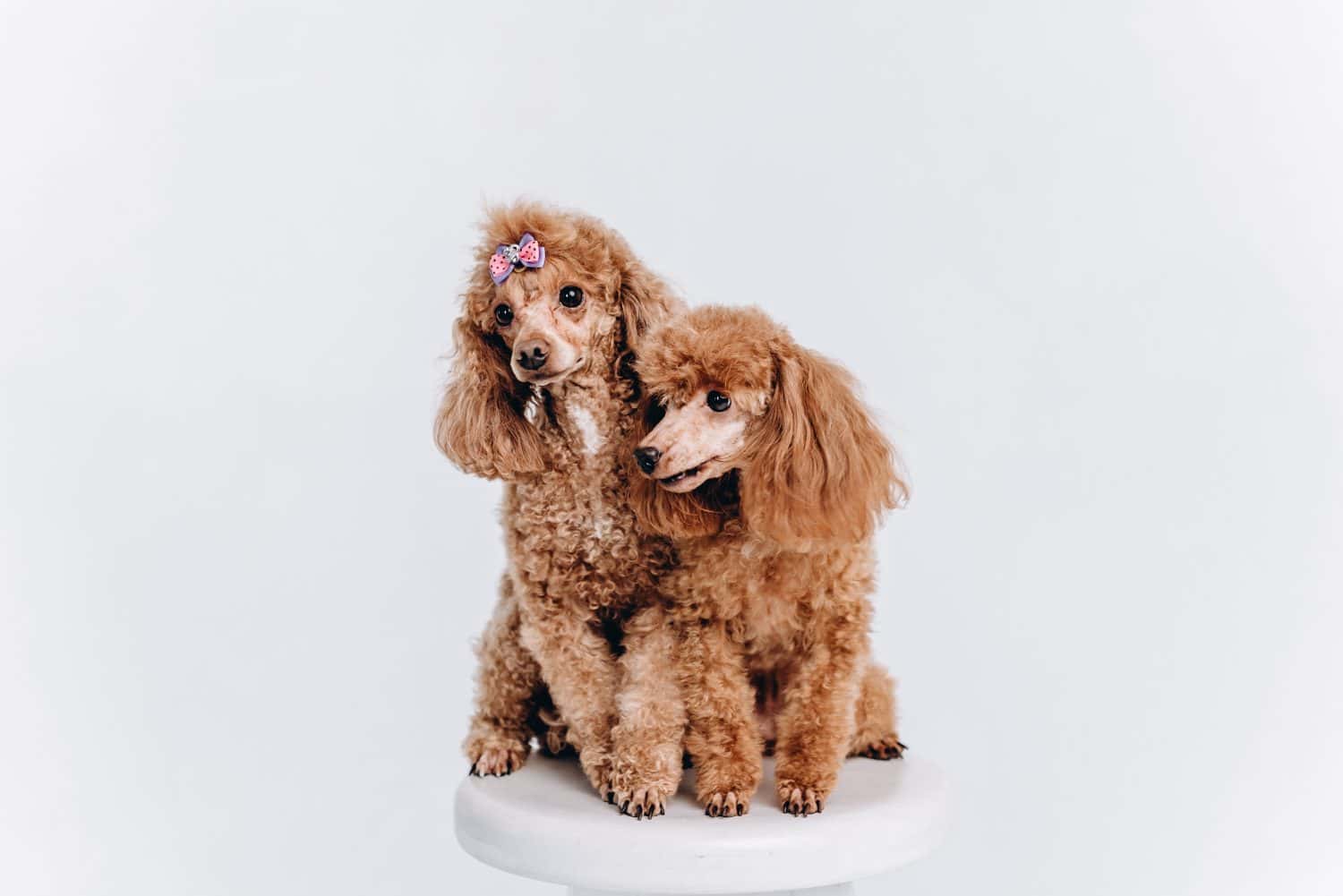Intelligent, energetic, and friendly, poodles are a beloved dog breed known for their exceptional ability to perform and their fluffy hair that is often groomed into adorable hair-dos. In recent years, many people’s exposure to poodles come from the proliferation of poodle cross-breeds, such as the “cockapoo” (Cocker spaniel and poodle), “maltipoo” (Maltese and poodle), “labradoodle” (Labrador retriever and poodle), and the uber-trendy “golden doodle” (golden retriever and poodle). However, purebred poodles are a special breed all on their own and can be a lively, active, and loving addition to a family. However, as you research poodles, you may wonder, “what are the differences between male and female poodles?” This article seeks to answer that question by comparing male vs. female poodles and summarizing the differences in size, health, temperament, trainability, and more. Let’s learn all about male vs. female poodles together now, starting with the basics of the breed!
About Poodles

Poodles are active and intelligent dogs originally bred to be duck hunters.
©iStock.com/Laura Fay
Today’s purebred poodle is descended from a dog breed rooted in 15th-century Germany. According to poodle history, these dogs were initially bred for hunting. Since hunting requires sharp intelligence, awareness, and energy, poodles were known to be smart and active dogs. The French picked up breeding early poodles and bred “Caniche” dogs. Caniche translates into “duck dog” in English and refers to the poodle’s role in duck hunting. Over time, poodles became a popular dog breed favored by Europe’s nobility and even royalty. This history helps explain how poodles got a reputation for being fancy or even snobby – often associated with elaborate grooming practices and assumed to be fussy pets.
While it is true that poodles require regular grooming and do often have predictable health problems, this breed is nevertheless one of smart, affectionate, and easy-to-train dogs. They are easy to train, and a long line of show-bred poodles have competed in dog shows and competitions to show off their skills. They also tend to get along very well with children, which makes them a more suitable addition to a family than some other dog breeds. That alone makes poodles a great candidate for adoption by families looking to give their children a furry friend to grow up with.
Three Sizes of Poodles
Poodles are one breed in different sizes. There is the tiny toy poodle. Then there is the mid-sized miniature poodle. Lastly, the largest size is the standard poodle. However, according to the American Kennel Club, all three of these sizes fall under the same breed. They are also all expected to comply with the same breed standard.
However, since some of the details of a poodle can vary depending on its size, this article focuses primarily on the standard poodle, the largest of the three.
With that in mind, let’s get into some of the differences between male and female standard poodles now!
Comparing Male vs. Female Poodles
| Attribute | Male Standard Poodle | Female Standard Poodle |
|---|---|---|
| Height | 18-24 inches | 18-24 inches |
| Weight | 60-70 pounds | 40-50 pounds |
| Health Risks | Poodles are known to have genetic health conditions and suffer from bloat, epilepsy, hip dysplasia, hypothyroidism, and other health issues. Male dogs are susceptible to testicular cancer, but you can mitigate this risk by neutering your male dog. | Female poodles face the same genetic health risks as male poodles. However, they also face a significant risk of mammary tumors, which could be cancerous or non-cancerous. |
| Temperament | Male poodles tend to be easygoing, playful, and sociable, with a strong desire to be with and get attention from its humans. Poodles as a whole are extremely intelligent and known for being among the smartest dog breeds. | Female poodles tend to be more stubborn than male poodles, particularly if they are not spayed. As a result, firm and consistent training is vital in order to maintain order and control over a female poodle. While female poodles do not crave the same level of attention as male poodles, they do tend to get attached to one member of the family and be extremely loyal to that person. |
| Response to Training | Male poodles respond quickly and enthusiastically to training since they are affectionate and eager to please. | Female poodles need to receive firm and consistent training and get the message about who’s in charge. As natural “alpha dogs,” female poodles may want to boss around their owner. However, with enough effort and intentionality, female poodles are good at obedience and want to learn new tricks and commands. |
Key Differences Between Male and Female Poodles

Male and female standard poodles tend to reach the same heights, but male poodles usually significantly more than female poodles.
©Lisjatina/Shutterstock.com
In this article, you will learn about the general differences between male and female standard poodles. Keep in mind that these facts may not hold true in every situation, and may or may not apply when talking about poodle cross-breeds or variations like the toy poodle. Ultimately, the key differences between male and female poodles come down to differences in size, health needs, temperament, and trainability. Each of these differences can impact various aspects of life with your poodle – such as how your pet bonds with different members of the family, their behavior and how they respond to you teaching them commands, their health conditions and needs in older life, and more.
While male and female poodles may look very similar, there are some subtle differences between them. Knowing these can help you to tell the two apart. Let’s now take a more detailed look at these differences between male and female poodles.
Size

Standard poodles are much larger than toy poodles. Both male and female standard poodles typically grow to between 18 and 24 inches in height and weigh between 40 and 70 pounds.
©Velimir Zeland/Shutterstock.com
One of the most significant differences you may observe in male vs. female poodles is a discrepancy in size. While male and female poodles tend to grow to about the same height, their weights can differ drastically. A standard poodle often grows to a height between 18 and 24 inches. By the American Kennel Club Official Poodle Standards, full-grown poodles should reach over 15 inches tall when measuring from the ground to the highest point of their shoulders. This is true for both males and females.
However, male poodles typically weigh more, reaching weights between 45 and 70 pounds while female poodle weights usually max out at 60 pounds. According to American Kennel Club Official Poodle Standards, a typical adult male grows to between 60 and 70 pounds. By the same standards, adult females should be between 40 and 50 pounds.
Maturity

Standard poodles typically reach their full size and weight by 24 months old or sooner.
©Ray Geiger/Shutterstock.com
At six months old, your male poodle will likely weigh between 40 and 50 pounds. A six-month-old female poodle, however, may only weigh between 30 and 35 pounds. By the time your poodle reaches 11 to 12 months of age, they should have reached most of their full weight.
Many poodles reach their full height much earlier, often by the six-month mark. However, they could keep growing and add up to several inches of height between the six-month and 24-month mark. At 24 months old, your poodle should have reached its full height as measured from the floor to its highest point at their shoulders.
Poodles are considered to be fully grown at 24 months (two years) old. Starting around its 18-month mark, your poodle puppy should also start to demonstrate signs of greater maturity, including a more calm personality and the loss of puppy mischievousness.
Physical Traits

Poodles are famous for having elaborate grooming styles.
©Svetlana Valoueva/Shutterstock.com
Both male and female poodles have lean, athletic bodies and a well-balanced physique. Their coats have dense, curly hair that can be styled into incredible designs, but does require regular grooming. In fact, both male and female poodles have wiry outer hair and a dense undercoat. Since these two can quickly become matted if not maintained properly, having a regular grooming routine is very important to keep your poodle happy and healthy. Most poodle groomers suggest brushing a poodle’s coat daily and establishing a consistent rhythm for professional grooming about every 6 weeks.
Interestingly, in order to compete as a show dog, adult poodles can only have one of three official and approved hairdos. Poodle puppies have their own designated hairstyle called “the puppy clip,” which is the same length of hair all over the body. However, poodles not competing in show dog competitions can sport all kinds of amazing and creative hairstyles!
Temperament

Standard poodles are known for being intelligent, friendly, and playful, and for being highly trainable.
©nieriss/Shutterstock.com
In general, poodles as a breed have a reputation for being energetic, active, friendly, loyal, and playful. Some have strong protective instincts, but they are not typically aggressive. They are also famous for being among the smartest dog breeds. This intelligence, combined with their eagerness to please, makes them excellent guide dogs and task-motivated dogs. However, while these qualities apply to both male and female poodles, there are a few differences in male vs. female poodles’ temperaments.
In general, male poodles are said to be calmer and more easy-going, docile, and affectionate. Some describe male poodles as “needy” for wanting lots of attention and time spent with their family members. Because male poodles become so firmly attached to their family members and have a desire to please, training them may be somewhat easier.
Since female poodles demonstrate strong loyalty and faithfulness to their family, and especially attach to one family member in particular, building a strong and healthy relationship with a female poodle is possible – it may just take a bit more effort than training a male poodle. However, in general, poodles take training seriously and are very obedient. Just remember that your female poodle may see herself as the alpha in the family – and you have to show her who’s in charge.
Response to Training

Standard poodles are relatively easy to train and are very eager to please.
©iStock.com/OneToRemember
In keeping with their differences in temperament, male and female poodles may have slightly different responses to training. Since they strive to make their owners happy, male poodles may pick up training quickly and with little resistance. Since male poodles are often extremely affectionate and friendly, they experience training as quality time with the people they love and will eagerly participate.
On the flip side, since female poodles may be more assertive and exert dominance, some might try to resist control or training by a human owner. Their strong will and fierce independence can make training relatively more difficult. Because of that, new poodle owners may find that female poodles need to be trained with consistency and firmness.
However, this breed as a whole is playful, intelligent, and highly trainable. Some dog lovers even argue that poodles are one of the most trainable dog breeds out there! In fact, poodles’ sharp intelligence and eagerness to please make them really good service dogs. Poodles have other jobs too! For example, they make great guide dogs and helpers for people with other physical disabilities. Recently, many poodles have found jobs as therapy dogs.
Health Considerations

Poodles were originally bred for hunting but quickly became associated with royalty.
©Diana Kellior/Shutterstock.com
Unfortunately, purebred poodles are more susceptible to genetic health issues. Known health concerns for the breed include bloat, epilepsy, hip dysplasia, hypothyroidism, and other issues. Additionally, standard poodles do face an increased risk of an aggressive cancer known as squamous cell carcinoma of the digit. This form of cancer is found on a dog’s toes. However, it is most prevalent in dark-colored poodles and rarely found on poodles with white or light-colored coats. Both male and female poodles are susceptible to the same genetic health conditions and risk of this type of cancer.
However, female poodles do run the risk of getting illnesses that are not an issue for male poodles. For example, male poodles have a lower risk of getting urinary tract infections compared to their female counterparts. Interestingly, you may even see a difference in your female poodle’s hair after she gives birth to puppies! Like human hair, poodle hair changes with hormonal shifts in the body. This can lead to female poodles having hair loss or thinning after they have puppies.
Male poodles do run the risk of contracting testicular cancer. However, this can be mitigated by neutering your male dog. Similarly, female poodles are at risk of mammary cancer. Mammary tumors are commonly diagnosed in female dogs and may be either cancerous or non-cancerous.
Sexual Maturity and Reproduction

Standard poodle puppies are playful and sometimes get into mischief. However, they tend to calm down by 18 months old.
©Jennifer Stidham/Shutterstock.com
Poodles typically reach sexual maturity between 6 and 8 months of age. However, this can vary with the specific dog. Most poodles go into heat for the first time at 8 to 12 months old, though some take longer. Many experts recommend spaying a female poodle before her first heat, in order to ensure her long-term health and well-being. However, a general rule of thumb from vets is to spay or neuter your dog by the 6-month mark.
When not neutered or spayed, the male and female reproductive roles of poodles are very distinct. Male poodles are responsible for fertilizing a female’s eggs during mating. Female poodles are responsible for carrying, birthing, and nursing the pups.
Summary

Both male and female poodles are great pets, but they do have some small differences when it comes to size, health, temperament, and trainability.
©cynoclub/Shutterstock.com
Overall, standard poodles are great dogs that can become very loving members of the family regardless of whether your dog is male or female. However, since their size, health needs, temperament, and trainability can vary, it is important to consider these four qualities when choosing between a male and female poodle!
Thank you for reading! Have some feedback for us? Contact the AZ Animals editorial team.








